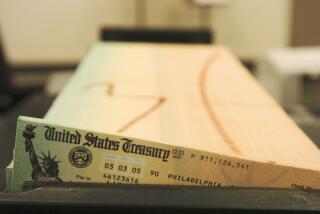Up to $100 Billion Extra Sought for S&L; Rescues : Bailout: House panelists are surprised and irritated. 223 additional institutions are listed as troubled.
- Share via
WASHINGTON — Federal officials said Tuesday that they will need to borrow an additional $50 billion to $100 billion to dispose of crippled savings and loan associations, far more than the $50 billion approved by Congress in August.
The funds will be needed as working capital by the Resolution Trust Corp., the agency dismantling crippled S&Ls;, to provide cash to pay off depositors at hundreds of defunct institutions. Officials said they need more money because a greater number of failing S&Ls; will require government action, and it is not known how much money can be recovered by selling those institutions’ assets.
The estimate offered Tuesday goes far beyond anything expected by members of Congress when they passed the landmark legislation rescuing the federal insurance fund that guarantees S&L; deposits of up to $100,000. Federal officials subsequently had said more money would be needed, but no one had suggested a figure as high as $100 billion until now.
The S&L; bailout law permitted the Resolution Trust Corp. to borrow funds by using seized assets of S&Ls; as collateral, but the huge size of projected borrowings surprised and irritated members of Congress at Tuesday’s hearing before a House Ways and Means oversight subcommittee.
L. William Seidman, Resolution Trust Corp. chairman, said that his agency will need to borrow between $50 billion and $100 billion, a broad range reflecting the uncertain recovery value of S&L; real estate assets.
Seidman disclosed also that officials have identified 223 additional troubled S&Ls;, with assets of $164 billion, as likely candidates for federal takeover in the next three years. The agency already has seized 283 institutions with $112 billion in assets.
After closing some institutions and selling the healthy mortgages and assets to other S&Ls;, the trust corporation will inherit 200,000 pieces of property, including condominiums, single-family homes, office buildings, shopping centers, raw land and assorted other real estate foreclosed on when loans went bad.
The agency needs huge sums of cash in the short term to close S&Ls; and pay off depositors, and it will not recover money until the sale of foreclosed properties months or years later.
Seidman’s statements met with immediate skepticism.
“You say to the American people you need $50 billion to $100 billion, but you do not have a plan” to raise the money, said Rep. J. J. Pickle (D-Tex.), chairman of the oversight subcommittee. “You leave yourself a lot of running room,” Pickle told Seidman.
“We have a lot of plans; we haven’t decided which one we will use,” Seidman replied.
The cheapest way to raise working capital would be direct borrowing by the Resolution Trust Corp. from the Treasury, Seidman said in response to questions. But another witness, Assistant Treasury Secretary David W. Mullins Jr., opposed this route, saying it would increase the federal budget deficit.
Seidman said federal officials are considering creation of a “resolution bank.” It might package the foreclosed assets of the S&Ls; and market them as securities to raise money. Or the bank could issue “junk bonds” with high interest rates, with S&L; assets as collateral for the bonds.
A skeptical Pickle said Congress does not “want to see unlimited borrowing to commit the full faith and credit of the federal government.”
Rep. Pete Stark (D-Oakland) said: “Nobody has the information (about the value of foreclosed assets.) Nobody knows what it’s worth.” He told Seidman: “You want a blank check to put a federal guarantee behind those assets. That’s absolutely irresponsible.”
Stark, Pickle and other members of Congress are promoting legislation to forbid unauthorized borrowing by new agencies such as the Resolution Trust Corp. Stark took his seat as a subcommittee member at the start of Tuesday’s hearing, then stepped down to the witness table to speak for his bill. If the corporation needs billions of dollars in working capital, he said, “the Administration should document this need, propose a plan to raise this capital and present the plan to Congress for specific legislative approval.”
To permit “this massive level of unfettered federal borrowing without prior congressional approval would be irresponsible,” he said.
Seidman said after the hearing that borrowing by the Resolution Trust Corp. “is simply an issue some members hadn’t focused on.” He said the agency could not provide a more precise estimate than $50 billion to $100 billion because “we’re talking about institutions we haven’t received yet. We haven’t been into them yet; we don’t know what the assets are.”
The Oversight Board, which sets policy for the trust corporation, issued a preliminary draft Tuesday of its strategic plan, inviting public comment on the best ways to dispose of crippled S&Ls.; The agency should sell S&L; assets with minimal “impact on local real estate and financial markets” and should emphasize the “availability and affordability of residential property for low- and moderate-income individuals,” the board said in its 77-page plan.
The board invited public comments for 30 days and said the final plan will be submitted to Congress by Dec. 31. Board members include Treasury Secretary Nicholas F. Brady, Housing and Urban Development Secretary Jack Kemp and Federal Reserve Chairman Alan Greenspan.
More to Read
Inside the business of entertainment
The Wide Shot brings you news, analysis and insights on everything from streaming wars to production — and what it all means for the future.
You may occasionally receive promotional content from the Los Angeles Times.










